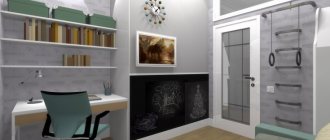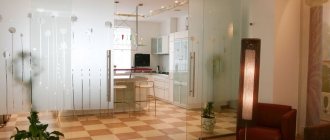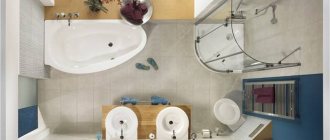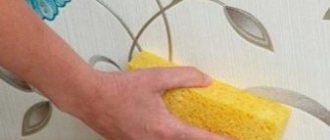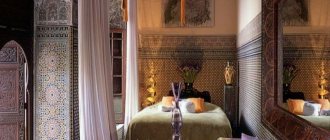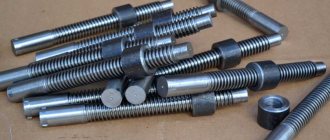Hello dear readers, and today I will tell you about the types of blinds that can be installed in the toilet by closing the plumbing pipes behind the toilet, or in another similar situation. I will try to make the article as illustrated as possible with photos and videos. Let's consider blinds that can be used to cover pipes in the toilet , ready-made in stores, and those that are made to order. I will write the article based on my many years of experience in the production of blinds, and at the end of the article you can read reviews from owners of blinds in the toilet behind the toilet .
Roller blinds for the toilet
Roller blinds for the toilet are one of the budget solutions for hiding plumbing pipes in the bathroom. There are a lot of options for roller blinds for the toilet. You can install not only free-hanging systems, but also cassette systems with a box and guides. You can purchase it either ready-made or made to order by contacting the manufacturer.
It will be more expensive to order, but ready-made ones will be cheaper. But here, most likely, you will need to work with your own hands, since the product will most likely be mounted in the opening, on the vertical wall of a standard toilet room layout. You need to choose curtains that are a little wider in width than needed, and then sawdust the fabric winding shaft at the top and the fabric plumb line at the bottom. It is also necessary to cut the fabric along the entire height and re-glue it.
You can also buy a canvas with an image already applied that suits your taste, or order a curtain with a specific image of yours.
The control of a sanitary roller blind can be chain, PIM (spring inertial mechanism) or automatic. The latter option, of course, will be inappropriate to install in the toilet in most cases. But you can think about PIM, in this case you won’t have a dangling control circuit, which can be very convenient.
- Execution options:
- Free-hanging
- Cassette
- Fabric
- Fabric with photo printing
- With chain control
- With spring
- Automatic
A separate article has been written in detail about all types of roller blinds and you can go to it by clicking the more details button.
Photos of roller blinds for the toilet
Vertical blinds for toilet
Vertical toilet blinds are another low-cost solution for hiding plumbing lines. But they are installed quite rarely, for the reason that the blinds canvas consists of many narrow slats that can touch pipes or other obstacles, causing the appearance to deteriorate. And such a property as turning the lamellas around their axis is not at all necessary for a toilet.
And the name vertical blinds does not come from the shape of the entire product (and in the toilet the product is often positioned vertically), but from the location of the slats. The slats on the cornice hang from top to bottom - vertically.
- Execution options:
- Fabric
- Plastic
- Aluminum
- Fabric with photo printing
- With chain control
- Automatic
Horizontal sanitary blinds
Horizontal sanitary blinds - in the toilet they are located vertically, but the slats on them are narrow strips, from which the blinds are made; the blinds are located horizontally, hence the name - horizontal blinds.
Reviews of blinds in the toilet
Dear friends, only high-quality reviews, comments or questions on the topic are accepted. Inappropriate reviews, advertising, spam and “cries of the soul” are deleted mercilessly! I'm hearing you. say so.
1″ :pagination=”pagination” :callback=”loadData” :options=”paginationOptions”>
Did you like the article? Follow new ideas from the world of construction, design, and useful tips in our channel. Subscribe to us in Yandex.Zen. Subscribe.
The product, called blinds or roller shutters for a toilet or bathroom, has already established itself on the market. It is distinguished by the strength and reliability of the mechanism. The simple design of the blinds has an attractive appearance and fits perfectly into the interior of any toilet room. The most popular today are roller or cassette blinds.
Roller shutters in the toilet are an excellent solution for masking utility lines
The easiest way out of roller shutters
https://www.youtube.com/watch?v=
In order to hide a wall with pipes without extra costs, it is recommended to use regular blinds. This budget method is perfect for those who do not want to build complex structures or are considering a temporary option. Wooden blinds fit perfectly into an eco-style, and plastic ones into a modern one. But if the bathroom interior is made in a classic style, the products are unlikely to fit into the overall design.
Plastic blinds will last as long as possible: they are practically not afraid of water and are easy to care for. The modern market offers a wide range of products, which allows you to choose a design to match the color of the finish. Unfortunately, the blinds do not have sound insulation, and also do not completely cover the pipes - you will have to build a separate box for the bottom.
If a major renovation is not planned, and the pipes do not fit into the interior, you can order a special wall cabinet. Its installation will not take much time, but some of the communications will be hidden.
Many women will appreciate another idea for decorating pipes in the toilet: an ordinary roller blind will help hide unsightly elements - the main thing is to purchase a product that is suitable in width and height. There will be no difficulties with its placement. Roller blinds come in a wide range of colors, and the material is protected with special antistatic and antibacterial compounds.
In the photo, bright blinds located at an angle successfully hide communications. In an emergency, they will allow you to instantly shut off the water supply.
For connoisseurs of the loft style, the situation is even simpler: if the toilet is designed in an industrial style, the pipes can serve as an excellent decor that matches the chosen style. You just need to put the communications in order by eliminating defects, cleaning off old layers or simply replacing them with modern ones.
The photo shows a loft-style bathroom - brickwork serves as finishing, and black pipes near the sink are painted the same color. Standing out against the terracotta background, exposed pipes become one of the main highlights of the interior.
Plastic is an ideal option for constructing a false wall; it is not afraid of humidity, temperature changes, and mold. rot, easy to clean, quickly disassembled if necessary. A significant advantage of the panels is that they do not have to be puttyed or painted - just choose the shade and pattern to match the color of the tile.
The color of the panels can be easily matched to the shade of the tiles
To attach the panels, you need to build the same frame as for a plasterboard screen. Use this method to make a false wall and a box. Laying ceramic tiles or applying textured plaster on a plastic coating will not work; for these cases you will have to choose drywall.
The fastest way to solve the problem of hiding the sewerage is with the help of roller shutters. This design maximizes access to the pipes, while there are no doors cluttering the space. Hanging blinds requires no experience, and beautiful curtains do not require any additional finishing.
Plumbing roller shutters are not only beautiful, but also practical
In response to the increased demand, manufacturers produce special sanitary roller shutters, endowing them with noise-insulating and heat-saving properties. If desired, it is easy to choose a color that harmonizes with the decoration of the entire room.
Why do you need blinds or roller shutters in the toilet?
Roller shutters will help hide unattractive pipes and valves, taps and drains in the bathroom or toilet, and also create the necessary atmosphere of homeliness and comfort even in the smallest bathrooms. With their help, it is possible to transform a bathroom from a technical one into a modern, comfortable and aesthetically attractive room.
Convenient design provides easy access to pipes and risers
Roller shutters go well with tiles in the bathroom, and the variety of colors and the presence of different patterns will help you make your choice without any problems.
With a convenient color combination, you can easily disguise blinds-cabinets in the bathroom. In such cabinets you can store household chemicals, use them as a pantry, or simply use blinds to cover pipes and other mechanisms in the toilet that spoil the appearance of the room.
Using blinds, you can hide meters and a water heater in a niche, and place discreet shelves for small items
Examples in the photo of how to close pipe blinds in the bathroom are located at the end of the article.
A big advantage of roller shutters is their quality, such as good sound insulation. Closed roller shutters help hide the noise of water in the pipes, which makes for a more comfortable stay in the toilet or bathroom.
Closed shutters will help you achieve perfection for your eyes and ears.
Roller shutters can not only carry a functional load, but also perform an aesthetic function
When is the best time to install roller shutters in a toilet?
Installation of sanitary roller shutters in the bathroom is allowed both in the initial stage of renovation and after the tile laying stage. Each of these options has its own characteristics.
If you prefer to install it after completing the renovation, you must remember that roller shutters will look good and harmonious in the toilet if the tiles were laid vertically. Otherwise, gaps will inevitably form between the wall and the guides. Over time, this can lead to serious problems. However, corners or sealant eliminate this defect.
Having chosen to install roller shutters at the beginning of renovation in the bathroom, all cracks and gaps between the guides and the wall are simply masked with tiles after installing the sanitary roller shutters. This saves tiles, which no longer need to be laid behind the blinds.
The best option for installation is to use a special box, which is located inside the cabinet and allows you to hide the rolled fabric. To install the box, you need to prepare a place for it. You will find the dimensions in the price list for sanitary roller blinds.
The photos below show roller shutters installed in the toilet, on the balcony, in the pantry, in the kitchen, in the niche for the washing machine and in many other places that mask openings and niches.
An example of installing roller shutters in a toilet in the video.
Horizontal or vertical blinds
More convenient for constant active use would be roller shutters for a vertical toilet. If you plan to use it infrequently, then in this case horizontal blinds are more appropriate.
Horizontal roller shutters are made of aluminum, plastic or wood.
Wooden curtains will act as an elegant interior detail, but will require periodic renewal of the protective coating
Plastic blinds are not subject to corrosion, are moisture resistant, are not affected by temperature changes, and are convenient and easy to clean and wash. They will last a very long time if used correctly. They do not have an exclusive design, but they stand out thanks to the rich color palette and can be combined with any tones of the bathrooms. Such blinds are not demanding and are cheap.
With care and proper care, plastic models can last for quite a long time.
Metal roller shutters have a more durable design. Aluminum is not afraid of moisture and temperature changes. The most interesting design solutions are manifested in aluminum roller shutters.
Metal systems are durable and moisture resistant
Realistic aluminum photographs with images of animals, birds, flowers, and landscapes are especially popular among consumers. The prices are higher than plastic, but the quality is much higher.
In relation to vertical ones, the horizontal type of construction is used much more often. This type of slats used in toilet cabinets are assembled and secured at the top. As practice has shown, horizontal blinds have proven themselves to be both easy to use and reliable, and the durability of the mechanism.
Horizontal slats are assembled into a box when the sash is opened
The latest developments of engineers are improved electronic blinds, which, when you press a button, fold and secure themselves.
Vertical roller shutters are more suitable for a simple bath or toilet, since a small bathroom using this type of blinds will visually appear even smaller. The slats in this model are located vertically - this is not entirely customary, but it looks quite stylish. The parameters of the slats vary depending on the width (from narrow to wide).
Vertical blinds are usually made of fabric
Video on how to close the riser
1. Overlay. This is the easiest installation method, when the structure is mounted on the surface of the walls. They are also suitable for thin walls, for example when pipes are separated from the room by plasterboard.
2. Inset with the box facing outwards. In this case, the roller shutters are installed flush with the wall, but the frame remains on the outside. This is a more labor-intensive installation method compared to the previous one.
The easiest option for installing roller shutters
3. Insertion with the box inside. With this installation, the not-so-pretty roller shutter box will be hidden inside the plumbing cabinet, which means nothing will spoil the appearance. The main thing in this case is that the cabinet space accommodates the box itself.
The box is hidden in a closet and is not noticeable
A box or false wall made of PVC panels is another cheap and practical way to hide sewer and water pipes in the toilet. Plastic is not afraid of moisture and fungus, it is durable and lightweight, and easy to care for.
This method is appropriate if the entire bathroom is lined with PVC panels: then the box will fit perfectly into the interior. Installation of products with the right approach will not cause difficulties and will not take much time. In the event of an accident when dismantling the structure, the material will not be damaged - this is especially true for pipes that are not insured against leaks. After eliminating the damage, the box can be easily put back together.
In the photo, the sewer pipes in the toilet are hidden in a box made of plastic panels. Other walls are covered with ceramic tiles, but the finishing material is matched to match, so the difference is not immediately obvious.
A gypsum board box is a product that even a beginner can handle creating. First, as for PVC panels, a frame is constructed from a metal profile. Some people use wooden blocks, but metal is considered a more suitable material. The frame is covered with moisture-resistant plasterboard, since the toilet is a room with high humidity. It is recommended to decorate the finished structure with a suitable material: tiles, mosaics, paint or wallpaper.
The pipes can be partially sewn up, giving the box almost any shape (for example, leaving space for a sink and faucet, going around a water heater) or erecting an overall structure. If the pipes are located on the side or in the corner of the toilet, creating a box is the best choice, since the installation will leave a lot of free space.
The photo shows a box made of moisture-resistant plasterboard with a communication hatch and porcelain tile cladding.
To build a complex dimensional partition in a bathroom, you will need a lot of material and free space, which means the method is not suitable for a cramped toilet. The optimal solution is considered to be boxes that follow the curves of water supply units: they not only mask the pipes, but also serve as additional shelves for hygiene items. Various blinds also save useful space: unlike swing doors, they take up less space.
To minimize the loss of bathroom space, you can use hidden installation of pipes. This option is suitable for small toilets. It is implemented at the initial stage of repair and only after a complete replacement of communications with modern ones. For hidden installation, pipes made of copper or plastic are used: they are sewn directly into the wall or floor.
In an ordinary apartment with a separate bathroom, almost all the pipes are located in the toilet. This is where, as a rule, meters are located and taps are made. The already small toilet looks like a technical room. And the toilet ended up here completely by accident.
There are several ways to hide all this disgrace.
1. Construction of a false wall.
One of the simplest and most common options is to completely cover the riser in the toilet with plasterboard. You need to keep in mind that a false wall will take up about half a meter of free space. The toilet room is already small, and after sewing up the riser, not everyone will be able to sit freely on the toilet.
The solution is a wall-hung toilet. A special frame on which the plumbing fixture is mounted and the drain tank will be hidden behind the drywall. This will save space.
A false wall can be not only attractive, but also functional. If you equip the free space with shelves, you can store household items there.
2. Construction of a square box.
This method is suitable if all the pipes are in one corner. The box saves free space. And with this option, you need to leave the door opposite the meters and valves.
3. Equipment of an oblique false wall.
It goes at an acute angle to the side or back wall. It is advisable to use this method of masking the riser in the case when thinner pipes extend to the side from the main pipe. The toilet will have to be moved a little to the side.
4. Creating a multi-level box.
When pipes are “scattered along the walls” of the toilet room, it is better to build a multi-level structure. Each of its elements will cover a separate section of the network.
The box can be two-level or three-level. Building it, of course, is more difficult. But space is saved and you get stands for important little things.
The easiest way to hide the sewage system running in a technical niche is to use a false wall. Use plywood or chipboard as a material, but plasterboard is considered the best option. One sheet of dry plaster will be enough for the job; it must be green in color - this is what moisture-resistant drywall looks like, suitable for use in wet rooms.
A completely closed technical niche is difficult to see with the naked eye
The frame of the false wall is made of galvanized profiles (which is preferable) or wooden blocks. When marking the places where the profiles are attached, it is necessary to take into account that the distance between the partition and the riser must be at least 3 cm. First, the guide profiles are attached to the walls, then to the floor.
If you plan to decorate a plasterboard screen with tiles, then it is necessary to provide a distance between the rack profiles of no more than 40 cm. In cases where there are already ceramic tiles on the walls, drilling should be done in the joints between the tiles.
Drywall is cut according to pre-prepared drawings and attached to the frame using self-tapping screws. The finished wall is puttied and decorated taking into account your own wishes and the overall design. To make working with the inspection door easier and less noticeable, use a simple but convenient magnetic mount.
If your own experience is not enough to carry out high-quality repairs, you can always seek qualified help from specialists. Professionals will quickly evaluate all possible options, carry out calculations and forever hide the ugly sewer from view in the most appropriate way.
Is it possible to close a sewer riser? Yes, you can, the main thing is to do it right. There are several ways to do this job.
Application of a false wall. This is the most capital method. In order to make it, you will need plywood or chipboard
We also recommend that you pay attention to the drywall. Before installing the ceiling, completely remove all rust and paint the structure
Use galvanized profiles to frame the false wall. Attach the profiles to the walls, then to the floor. There should be a distance of 3 cm between the partitions. The drywall is secured to the frame using self-tapping screws. The sewer pipeline is hidden in the box. This design can be triangular or tetrahedral.
Plastic panels. This is a very practical material that is not affected by external irritants such as humidity, temperature changes, and mold. They are also easy to disassemble and assemble, no need to paint or putty. It is enough just to choose plastic panels of the required color. You will need to build a frame for the wall and box, and lay the panels.
We suggest you familiarize yourself with When water meters are changed according to the law
Roller shutters. If you don't want to waste time on complex methods, you can close the sewer pipes with roller shutters. They do not require finishing, they are easy to install, as they are ordinary blinds, and they provide maximum access to the riser. Now there are special designs, for example, with sound insulation and heat conservation.
- A box made of plasterboard or plastic. Use a metal profile and simply cover it with plastic.
- Utility cabinet. This is a great option to disguise valves, filters, meters and pipes and store cleaning products and household items. Make a frame from wooden blocks, secure it with dowels to the walls of the toilet, install hinges and doors. Laminated chipboard and plywood are suitable for making a cabinet.
So how can you close the riser in the bathroom? This can be done in a variety of ways:
- Disguise in the walls. In this way, you can hide the riser only at the stage of its installation. And the work is very difficult and time-consuming, be prepared for this. First you need to draw up and transfer to the wall a diagram of the location of all communications. Then, using a hammer drill, you should make recesses slightly larger than the diameter of the pipes. Next, pipes are laid in the grooves. Then it is advisable to cover the entire surface with plasterboard sheet, chipboard, plywood or PVC panels to make a kind of false wall. It is not recommended to fill the depressions with concrete; if it breaks and is dismantled, you can seriously damage the riser.
- Closet. Yes, you can hide the riser in the closet. Moreover, you can either purchase a ready-made piece of furniture with a missing back wall and slots in the shelves, or make it yourself from an ordinary one. You will need to remove the rear section. Then, using a crown and a drill, make holes in the shelves corresponding to the diameter of the pipes. This method will not only hide the riser, but also provide additional space for storing products or hygiene items.
- The box is the most common way to disguise communications. It is convenient because you can purchase a ready-made structure of the required dimensions at a plumbing store. It is easy to install, so installation will not be difficult. In addition, there are different options for shapes and configurations: triangular, rounded, rectangular boxes, as well as those consisting of one or several levels.
- Plasterboard partition. To mount it, you must first install a durable frame, which is usually made of galvanized profiles. Although some use wooden beams, this material requires additional treatment with moisture-protective and antifungal agents. Next, the plasterboard sheets themselves are attached to the frame using self-tapping screws, and it is advisable to use moisture-resistant ones, since the humidity in the bathroom is significantly increased. The next stage is finishing. You can use different materials, but the most practical and preferred are PVC panels and ceramic tiles.
- Construction made of plastic panels. Plastic panels are practical, inexpensive, moisture-resistant, lightweight and relatively easy to install, as they have convenient joints. But the only drawback of using them is the complete lack of sound insulation; any sounds will penetrate through them. If this does not bother you, then get to work. First, install the frame, which can be made in the same way as for a plasterboard partition. But in this case it is advisable to use a metal profile. Install plastic panels on it. The joints can be masked with corners.
- Roller shutters will not only hide all communications from view, but also provide unhindered access to them. At any time, you can move the shutter to, for example, open or close a valve or troubleshoot problems. Roller shutters are installed in guides. In this case, the riser itself should be located in a recess so that it does not interfere with the movement of the shutter. And along the edges of such a recess the frame of the future structure is mounted. Currently, you can purchase special roller shutters designed for bathrooms and toilet rooms. They not only play the role of camouflage, but also perform hydro- and sound-proofing functions, as they are equipped with an additional internal coating.
Types and advantages of roller shutters in bathrooms
Roller blinds for the toilet are the optimal solution, the durability of the design even with the most active use. Their mechanism consists of the following elements:
- canvas profile;
- guide rails;
- box;
- spring-inertial mechanism.
Installation of roller shutters with manual drive
Fabric blinds are made of cotton and silk, which are treated with special antiseptics and use moisture-resistant coatings.
Installation of vertical fabric blinds
Many consumers are afraid to use curtains of this type in toilets due to deformation of the slats and the appearance of fungal infections due to high humidity, as well as the presence of unpleasant odors. But the developers took into account all factors, and such a model meets all standards, which accordingly affects its cost.
Roller or cassette curtains in the toilet behind the toilet are by far the most commonly used in homes. The simple design, easy to use, fits perfectly into the interior of the bathroom and saves space.
Open roller blinds are the most budget-friendly way to disguise pipes
Roller blinds in the toilet behind the toilet are retracted using a chain. The curtain fabric is rolled into a roll, which fits into a box mounted on the ceiling of the bathroom.
Advantages
Noise protection
Plumbing roller shutters have internal voids filled with foam, so they successfully isolate sounds. Even if your water supply is made of PVC pipes, you will not hear any unnecessary noise.
Aesthetic appeal
Behind the roller shutters you can hide water supply and sewerage, meters and filters, shelves for placing various household accessories. Your bathroom will no longer be spoiled by the appearance of numerous powders, rags and mops!
Ease of access to communications
Roller shutters in the bathroom in problem areas are much more practical than tiles or panels. They do not have to be dismantled in the event of an accident. Possible leak locations will be accessible, as will meters for reading and filters for changing cartridges.
Durability
Roller shutters in the toilet behind the toilet will last a long time. They will not fade, will not rot from excess moisture, will not become deformed, will not rust, and will not allow fungus or mold to spread. Their pleasant appearance will decorate the room, pleasing the eye.
Types of roller shutters for the toilet according to installation method
There are three ways to install roller shutters
The first view is with a box inside the opening. This method is the most optimal. The main condition is the possibility of mounting the box. Before taking measurements, it is necessary to make sure the walls are leveled, which will allow you to fix the roller shutters to the wall without much effort.
Built-in installation of roller shutters - frame inside
Second view with the box outside the opening. This method is used in a situation where the box does not fit into the opening. Measurements are taken after the tile laying is completed, fasteners are made directly to the tile. In this design, it is very important to take into account the height of the opening, since in tall structures, when the roller shutter is opened, there will be a large number of turns of lamellas on the shaft, which reduces the opening.
Built-in installation – box outside
The third method is overlay. This method is used in the presence of plasterboard walls. In this design, the box is placed outside and equipped with a lower guide. When using this method, the height of the opening does not change and there is no need to attach the structure to the ceiling. Despite all the above points, the mechanism is quite simple and reliable in operation.
Surface mounting – box facing out
Types of blinds by type of design
To hide plumbing and engineering communications and organize additional storage spaces in the toilet, you have to use a lot of ingenuity and ingenuity. I would like to combine versatility, convenience and attractive appearance.
The type of design will depend on:
- bathroom sizes;
- opening dimensions;
- box placement options;
- intended purpose.
In a small room, horizontal products are most often installed in the color of the walls. With a very wide opening, it is possible to use wooden or metal structures that have high strength. If access to communications is cluttered, then roll models are best suited. In order to organize the placement of powders and cleaning products in a niche, it is necessary to secure storage shelves inside the box. In this case, the doors can be hinged.
Horizontal
The design of horizontal blinds consists of slats located one above the other. High-strength cords are stretched between them, inserted into round holes drilled along the edges of the planks. Control occurs thanks to a cane, with the help of which the slats can be turned perpendicularly and the meter readings can be recorded. If necessary, the slats are assembled at the top, opening the entire opening for inspection.
You can attach them to the ceiling or wall. Cleaning and washing is carried out using a rag or brush. It is necessary to remove dust with a vacuum cleaner very carefully; with modern electric mechanisms the suction power is so high that it can bend and crush the slats.
If the bathroom area is large, then designers use two designs: the first closes the niche, and the second acts as a false window element on the opposite wall, combining the space into a single whole.
Vertical
This curtain design is used in spacious bathrooms, since longitudinal slats will visually make a small room even narrower. Vertical blinds, unlike horizontal ones, are more resistant to damage because they are mainly made of flexible materials. If necessary, they can simply be moved to the side by hand.
According to the intended purpose and material of manufacture, they are distinguished:
- plastic - as false partitions;
- multi-textured - for zoning;
- pleated - for decoration.
For use as curtains, multi-textured blinds made from various layers of fabric and plastic are popular, which is very practical and original. For non-standard openings such as an arch or trapezoid, there is an alternative - a pleated model (fabric assembled with an accordion). There are a huge number of different modifications, for example, the honeycomb-shaped structure is very unusual, in which folds in two layers are glued together. Plastic vertical slats are used to imitate partitions.
Roller blinds
Roller blinds have a second name - roller shutters. These are blinds with a special protective function, made in the form of two guides, a roll in the upper part of the structure and plates moving along these guides. The most durable and expensive type of all structures. They do not require special care; accumulated dust can be wiped off with a damp cloth.
The advantages of using this model are:
- high protective functions;
- reliability of mechanisms;
- anti-corrosion;
- durability.
This type of design is suitable for spacious rooms; in a small bathroom it will look massive and awkward. The bottom is usually equipped with a locking device. Indispensable in case of limited access to meters.
Rolled
Roller blinds (fabric roller blinds) are a rectangular piece of special fabric wound on a tubular shaft located at the top. The canvas material is impregnated with a special composition that prevents the formation of fringe along the edges and the settling of dust. This design is controlled using an electric drive or a thin cord.
Benefits of use:
- wide range of colors;
- light weight;
- simple design;
- low price.
No special preparation is required during installation; the structures are attached to the wall or ceiling. In small rooms they save space and provide unhindered access to communications.
Roller shutter with manual spring-inertia control mechanism (PIM)
According to the control mechanism, roller shutters are divided into mechanical and automatic. For home use, the best option is mechanically controlled roller shutters, which have the following elements:
- Belt and cord drive. Cheap and easy to use device. The mechanism includes a cord attached to the shaft. This option is used in structures up to 520 mm wide. The disadvantage is that it cannot be fixed in an intermediate position.
The cord mechanism is the simplest and most inexpensive way to control
Roller shutters with a spring-inertial mechanism are more expensive, but more convenient to use
Choosing blinds for the toilet: tips and tricks
To create a comfortable psychological climate in a bathroom or toilet, you need to select blinds based on the following factors:
- you need to take into account the color and texture of the furniture;
- models and colors of plumbing fixtures;
- color and pattern on the walls of the bathroom;
- selection of fittings (the durability of the mechanism depends on such little things);
- special requirements for wooden and fabric blinds.
The most important thing is accurate calculations, measurements and the correct location for installing the blinds.
Roller shutters in a contrasting color will stand out against the background of the walls and make the interior more interesting.
How to get rid of a pipe once and for all
For those who are not looking for easy ways and prefer to do everything thoroughly, there is a radical way to get rid of the riser - moving it to the wall. As a result, the area of the room is not reduced; a flat and smooth wall fits perfectly into the interior conceived by the designers.
The walls will become smooth and nothing will disturb the harmony
This option is not possible in every house, but only where the thickness of the partitions allows cutting out the grooves. The capital method will require a complete replacement of communications, including passages through ceilings, you will have to notify neighbors, and incur additional costs.
We suggest you read: How to clean the sink in the kitchen and bathroom
Another way to remove unsightly parts is to install hanging plumbing fixtures. This process requires a professional approach; the thickness of the walls does not always allow this.
Hanging plumbing not only hides ugly pipes, but also adds lightness to the room
When is the best time to install roller shutters in a bathroom?
It is best to install these mechanisms after renovating the bathroom or any other room. The main condition is smooth walls, otherwise the blinds will not look entirely aesthetically pleasing. If the room has smooth walls, floors and ceilings, you can safely install roller shutters.
Roller shutters with an overhead installation method are installed after completion of the repair
This article will help you find all the questions you need regarding construction, technical, design and price aspects before making a decision about which blinds are right for the buyer for a bathroom or toilet.



